|
|
Cotton |
|||||||||||||||||||||||||||||||||||||||||||||||||||||||||||||||||||||||||||||||||||||||||||||||||||||||||||||||||||||||||||||||||||||||||||
| 09 January 2016 03:38 PM | |||||||||||||||||||||||||||||||||||||||||||||||||||||||||||||||||||||||||||||||||||||||||||||||||||||||||||||||||||||||||||||||||||||||||||
 | |||||||||||||||||||||||||||||||||||||||||||||||||||||||||||||||||||||||||||||||||||||||||||||||||||||||||||||||||||||||||||||||||||||||||||
|
Cotton is known to have originated from the Indian sub-continent. It was proved from the available evidence (from the relics of Mohanjo-daro civilization) that India was the original habitat for the old world cotton. However, in the present day world, four major cultivated species of cotton including Gossypium arboreum L., G. herbaceum L., G. hirsutum L. and G. barbadense L. are grown in the world as well as in India.
Cotton is one of the most important commercial crops and a chief fiber crop that provides raw material for textile industry. Though, a large number of countries produce cotton, only seven countries contribute for about 80% of total world cotton production. India has occupied the first place in terms of area cultivated under cotton, but could not achieve the same in terms of production owing to low productivity levels.
Nevertheless, with a sharp increase in yields since the mid 2000s, India outpaced the U.S. and reached the second position in the top producers’ list only next to China. Further, India has been in the second position in terms of consumption and demand has been growing consistently with rising population. More importantly, India has become the top big exporter of cotton after the U.S. since 2005-06.
Economically Important Products
Cotton is cultivated primarily for lint while seed and its by-products have also gained commercial importance in recent times.
Cotton composition:
Lint or fiber: 35-45%
Seed: 55-65%
Seed oil: 10-12% Meal and Hull: 35-40%
Climate and Cultivation
Cotton is a tropical and subtropical crop, comes up well up to 500m mean sea level and a short cool season before harvest is useful for high yields. Cotton requires four to five months of uniformly high temperature during its growth period. Optimum temperature for vegetative growth ranges from 21o to 28o C while relatively higher day temperature of 27o to 32oC and cool night favors flowering and boll formation. However, with sufficient soil moisture, the crop can withstand up to 45o C but for shorter periods. A minimum of 500 mm of well distributed rainfall is essential, particularly in the initial stages of growth. Sunny days are important at all stages of growth, particularly during flowering and maturity stages.
Seasons and crop calendar
Although sowing season varies widely across the regions, majority of sowing falls between March and July in India as well as other major producing countries except for China and Brazil.
 In India, sowing under irrigated conditions take place between March and May, while it spreads between June and July under rainfed conditions, particularly in southern parts. Harvesting accordingly falls between September to April. Majority of cotton cultivated in the country is under rainfed conditions (65%) and only about 35% has irrigation facilities.
 World Scenario
World cotton production, after falling short for two consecutive years (2008-09 and 2009-10), once again moved up in the subsequent years and reached a new record high of 126 million bales in 2011-12 though moderated thereafter. The increase in output could mainly be attributed to a substantial increase in production in India. Cotton output in India has steadily posted a significant increase from 2004-05 onwards while that of the U.S. has declined rather steeply. As a result, India became the second largest producer of cotton in the world.
Table 1: Cotton Balance Sheet (Million Bales Of 480 lbs)
P: Projected Source: USDA
Unlike production, consumption is sluggish during the past three years and trade is estimated to decline by about 15% on account of a record trade in the previous year as well as a significant growth in output of major producing countries in the current year (2013-14).
Table 2: Top Five Countries With Respect To Production, Consumption And Trade
Source: USDA
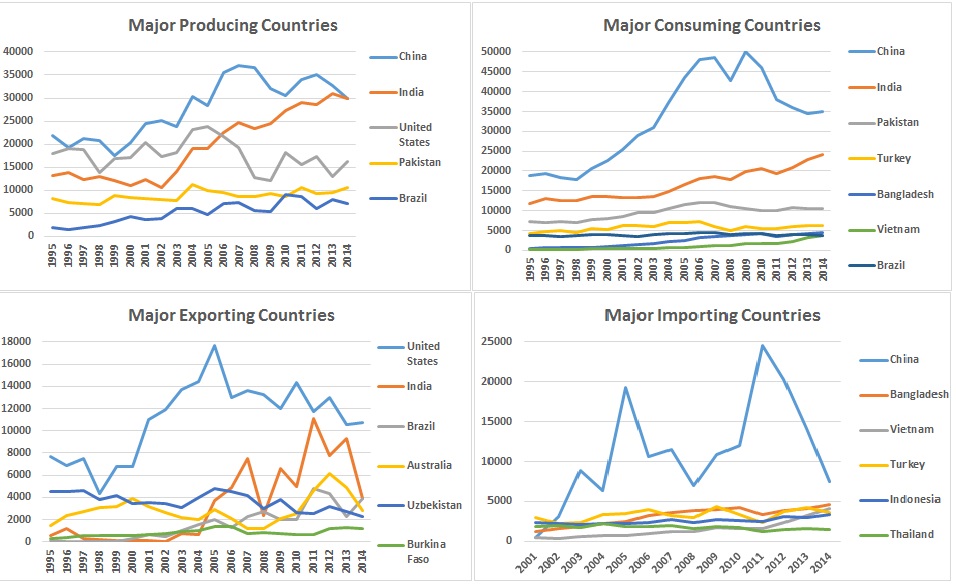 (Cotton in thousand bales of 480 lbs each) Source: USDA
Domestic Scenario Cotton production in India has increased steadily from the mid 1980s to 1990s but thereafter, it has declined marginally on account of stagnation in yields and fluctuations in cultivated areas. However, cotton yield has shown a remarkable increase in the late 2000s. Cotton production in the country is estimated to be at around 365 lakh bales in 2015-16, about 3.9% lesser than that in the previous year, as per the latest estimates published by the Textile Ministry, estimated by Cotton Advisory Board (CAB).
 Sources: Textile Ministry, estimated by Cotton Advisory Board (CAB)
Cotton production increased steadily and rather steeply from 2004-05 onwards and doubled during the past decade from about 179 lakh bales in 2003-04 to about 398 lakh bales in 2013-14 primarily due to a sharp rise in yield. Incidentally, the period of sharp rise in yield was coincided with the introduction of genetically modified Bt-cotton. Nevertheless, the yields have started moderating from 2008-09 onwards and stabilized at around 500kg/ha.
Table 3: Balance Sheet Of Cotton In India (Lakh Bales Of 170kg Each)
P: Projected Source: Office of Textile Commissioner, estimated by Cotton Advisory Board (CAB)
In addition to the estimates prepared by the Ministry of agriculture, CAB also estimates cotton output at regular intervals. But, the estimates by the ministry are based on the crop year (June-May) while that of CAB are based on marketing year (October-September). As a result, there is a significant difference between these two estimates.
State-wise Production
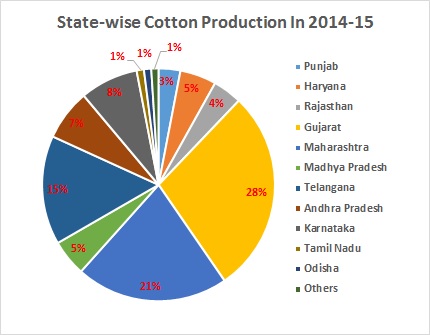 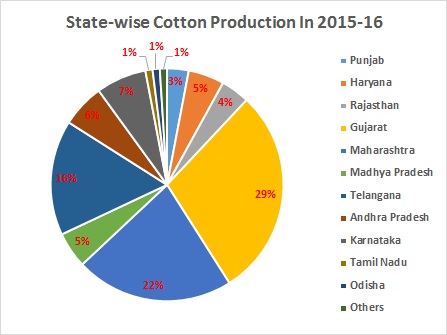 Source: Office of Textile Commissioner, estimated by Cotton Advisory Board (CAB)
Among all the major states that produce cotton, Gujarat, Maharashtra and Andhra Pradesh occupy the first three places, accounting for over 70% of total domestic production. Maharashtra has the largest area under cotton cultivation (34%) but it contributes for only 21% of total production, next to Gujarat at 35%. Andhra Pradesh occupies the third place in the country, both in terms of area and production. The latest estimates of state-wise cotton production for 2011-12 indicated a uniform increase in production in all the three major states. Among other states, Haryana, Karnataka, Rajasthan and Madhya Pradesh also witnessed a significant increase in the past few years.
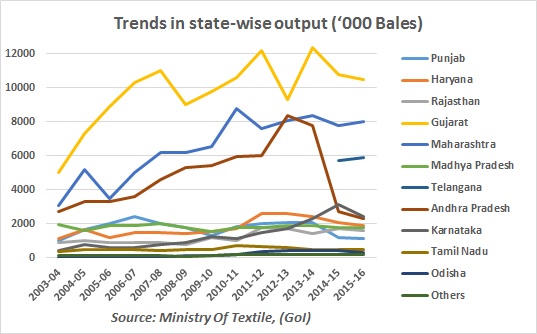 Source: Office of Textile Commissioner, estimated by Cotton Advisory Board (CAB)
Genetically Modified or Bt-Cotton
Any organism or plant whose genetic constitution has been altered by the introduction or elimination of a specific DNA sequence or gene as a whole through recombinant DNA technology is called genetically modified organism/plant. In case of Bt-cotton, to provide resistance against bollworm, a specific gene from a soil bacterium (Bacillus thuringenesis), that stimulates production a particular protein called Bt-toxin and is harmful for bollworm (lepidopteran insects), is inserted into a cotton variety.
Field trials of Bt cotton were initiated in 1998 by Mahyco-Monsanto Biotech, a joint venture of multinational company Monsanto and Maharashtra Hybrid Seed Company. Major Bt-cotton varieties are MECH-1, H-4, S-6, S-4.
Major cultivated varieties
Gujarat: S-6, S-4 AP: MCU-5, DCH-32 Northern India: J-34 Maharashtra: MECH-1 MAJOR MARKETS:
Spot Markets
Central India: Akola, Aurangabad, Ahmedabad, Mumbai, Surendranagar, Indore, Khargaon.
South-India: Adilabad, Karim Nagar, Khammam, Guntur, Warangal, Kurnool, Coimbatore, Gulbarga.
North-India: Hisar, Sirsa, Bhatinda, Sriganganagar, Abhor, Mansa, Delhi, Ludhiana.
Futures Markets
Trading in futures of cotton and its products is offered on the following exchanges:
External Trade
Cotton trade, though remained highly fluctuating, has increased significantly during the past 10 years. A significant growth in exports was witnessed from 2004-05 onwards in line with the sharp rise in production and the consequent surplus output in the country. As a result, imports dipped and remained at a marginal level for over a decade.
China is the single largest export destination for India, followed by Bangladesh and Pakistan. Marginal quantities are also exported to Vietnam, Indonesia, Taiwan and Malaysia. Cotton exports to China have accounted for about 80% in 2011-12 as compared with about 54% a year before. 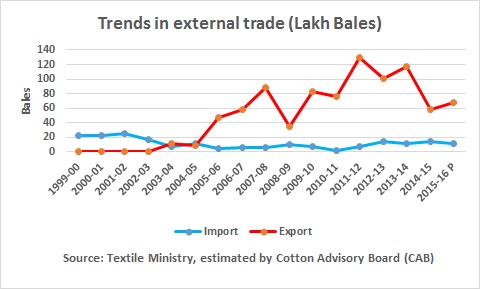 Source: Office of Textile Commissioner, estimates by Cotton Advisory Board (CAB)
Only a marginal quantity of cotton has been imported during the past 10 years. Imports mainly comprise extra long staple varieties of Giza and Pima from Egypt ad US respectively. In addition, small quantities of short and medium staple cotton also imported from Pakistan and African countries respectively depending on the domestic demand.
Major export destinations: China, Bangladesh, Pakistan and Vietnam
Major import sources: Egypt, U.S., Pakistan and African countries.
Factors Influencing Prices:
|
|||||||||||||||||||||||||||||||||||||||||||||||||||||||||||||||||||||||||||||||||||||||||||||||||||||||||||||||||||||||||||||||||||||||||||
Copyright © CC Commodity Info Services LLP. All rights reserved.

